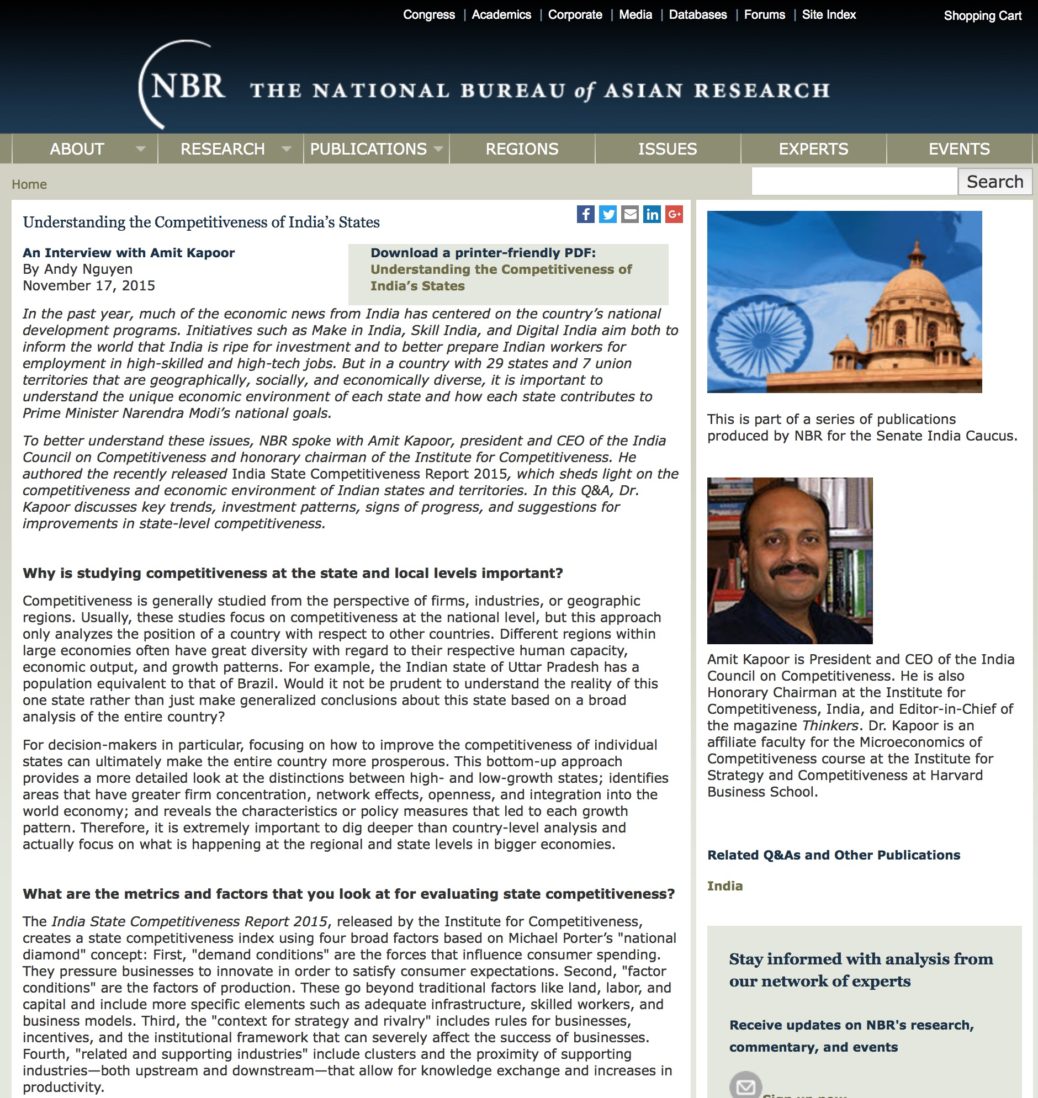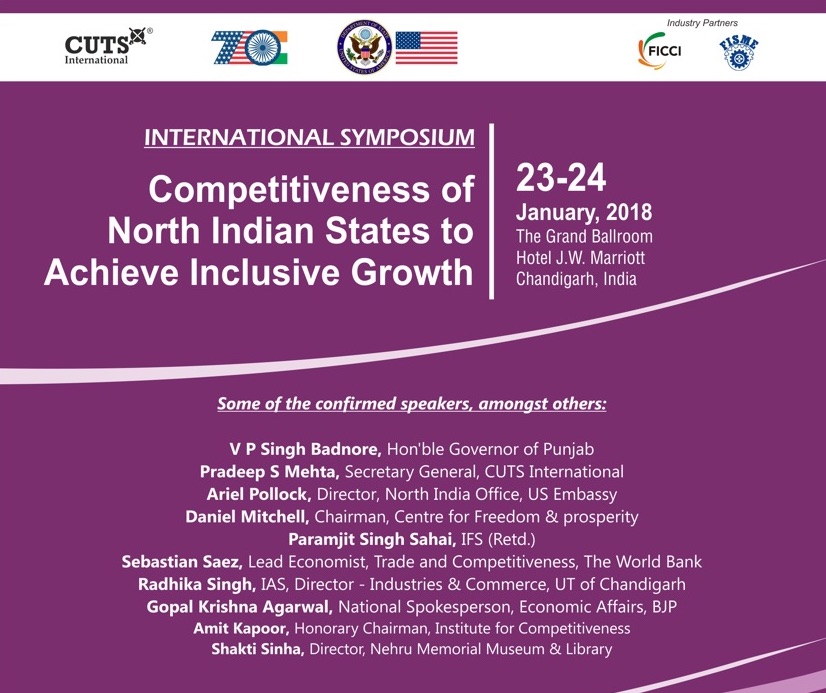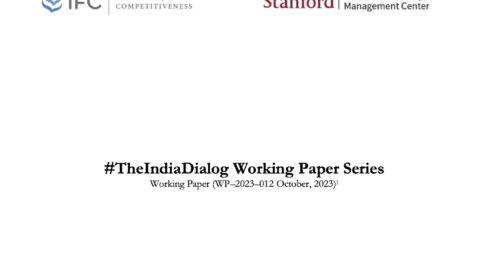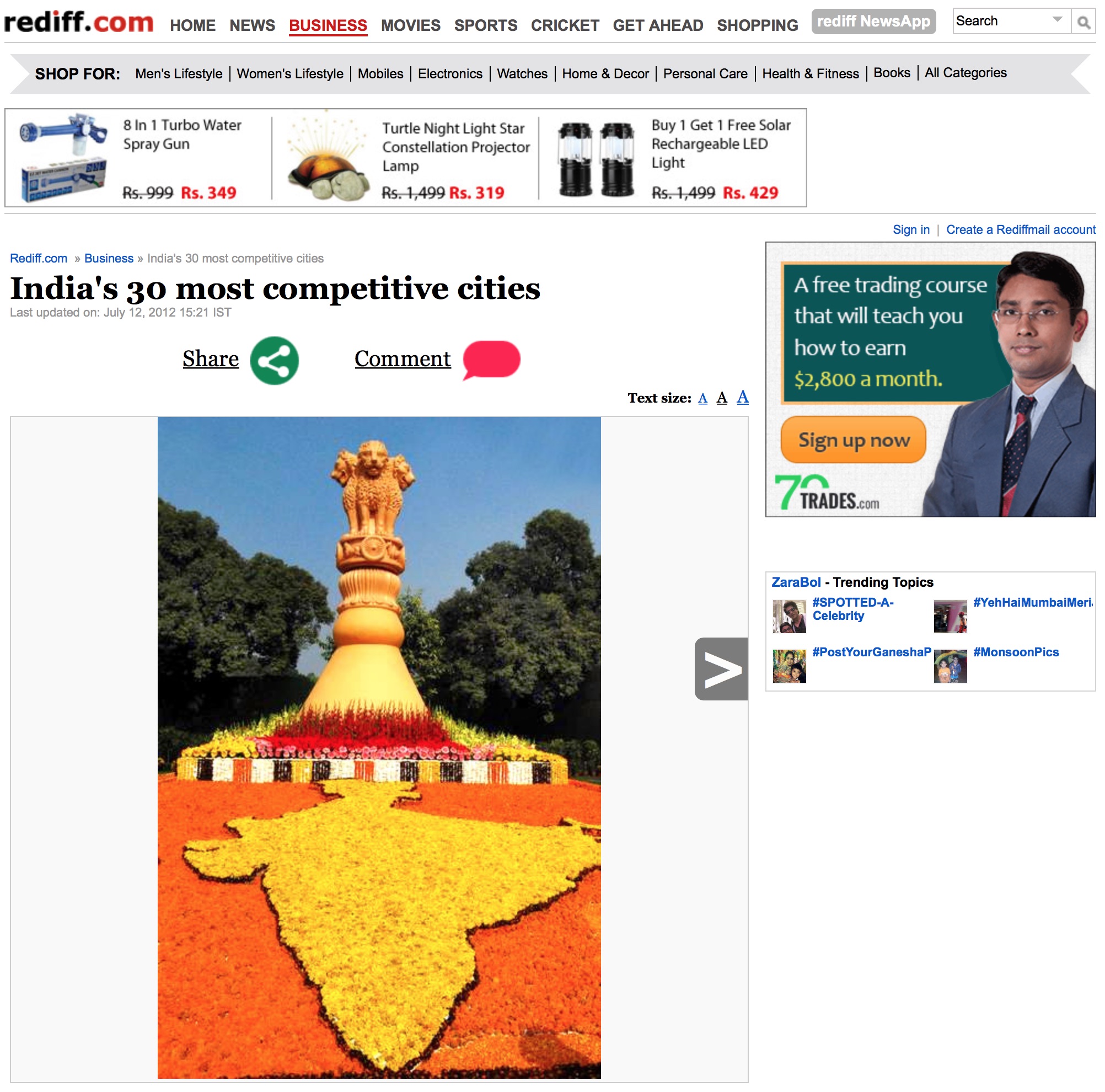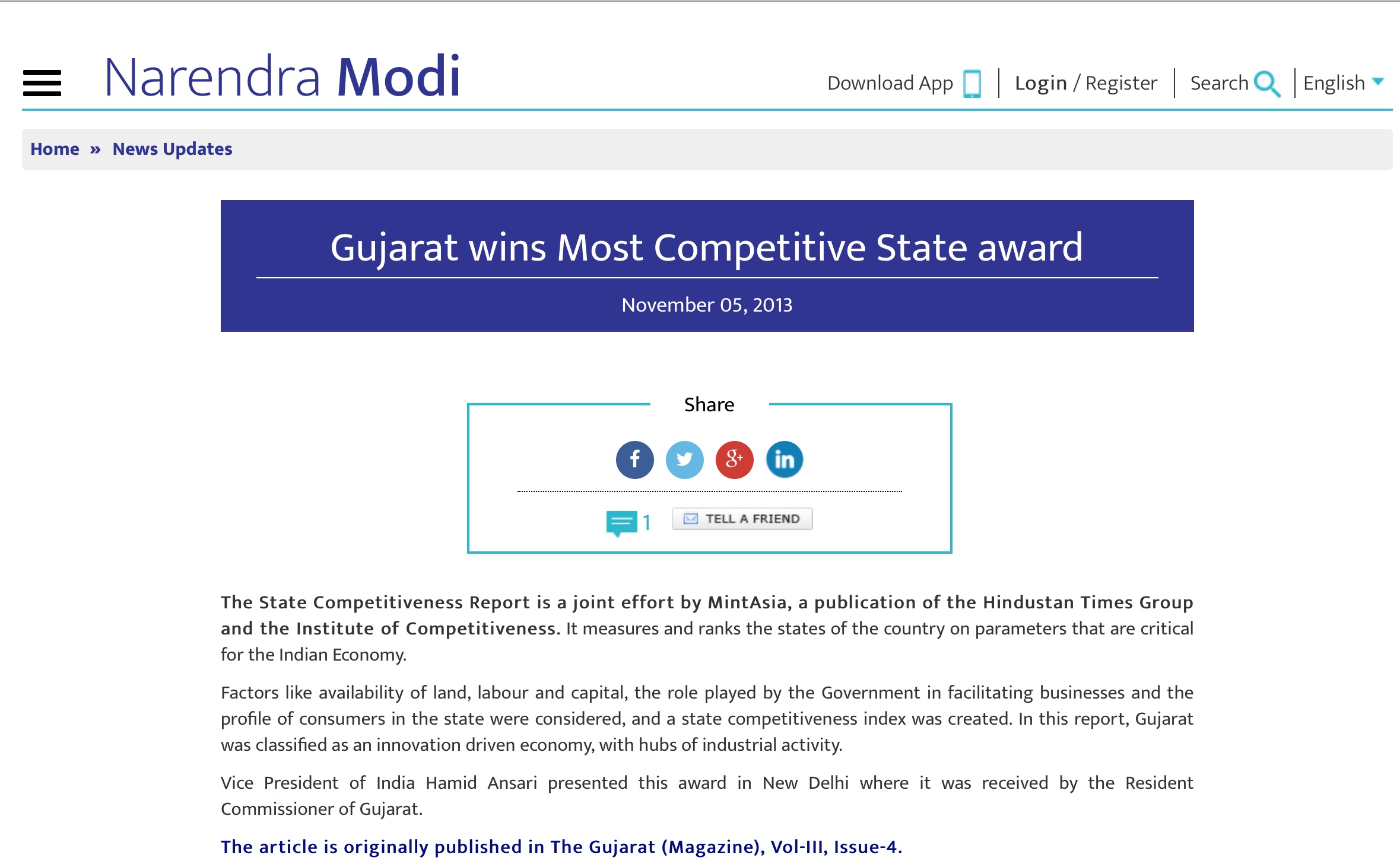An Interview with Amit Kapoor
By Andy Nguyen
November 10, 2015
In the past year, much of the economic news from India has centered on the country’s national development programs. Initiatives such as Make in India, Skill India, and Digital India aim both to inform the world that India is ripe for investment and to better prepare Indian workers for employment in high-skilled and high-tech jobs. But in a country with 29 states and 7 union territories that are geographically, socially, and economically diverse, it is important to understand the unique economic environment of each state and how each state contributes to Prime Minister Narendra Modi’s national goals.
To better understand these issues, NBR spoke with Amit Kapoor, president and CEO of the India Council on Competitiveness and honorary chairman of the Institute for Competitiveness. He authored the recently released India State Competitiveness Report 2015, which sheds light on the competitiveness and economic environment of Indian states and territories. In this Q&A, Dr. Kapoor discusses key trends, investment patterns, signs of progress, and suggestions for improvements in state-level competitiveness.
Why is studying competitiveness at the state and local levels important?
Competitiveness is generally studied from the perspective of firms, industries, or geographic regions. Usually, these studies focus on competitiveness at the national level, but this approach only analyzes the position of a country with respect to other countries. Different regions within large economies often have great diversity with regard to their respective human capacity, economic output, and growth patterns. For example, the Indian state of Uttar Pradesh has a population equivalent to that of Brazil. Would it not be prudent to understand the reality of this one state rather than just make generalized conclusions about this state based on a broad analysis of the entire country?
For decision-makers in particular, focusing on how to improve the competitiveness of individual states can ultimately make the entire country more prosperous. This bottom-up approach provides a more detailed look at the distinctions between high- and low-growth states; identifies areas that have greater firm concentration, network effects, openness, and integration into the world economy; and reveals the characteristics or policy measures that led to each growth pattern. Therefore, it is extremely important to dig deeper than country-level analysis and actually focus on what is happening at the regional and state levels in bigger economies.
What are the metrics and factors that you look at for evaluating state competitiveness?
The India State Competitiveness Report 2015, released by the Institute for Competitiveness, creates a state competitiveness index using four broad factors based on Michael Porter’s “national diamond” concept: First, “demand conditions” are the forces that influence consumer spending. They pressure businesses to innovate in order to satisfy consumer expectations. Second, “factor conditions” are the factors of production. These go beyond traditional factors like land, labor, and capital and include more specific elements such as adequate infrastructure, skilled workers, and business models. Third, the “context for strategy and rivalry” includes rules for businesses, incentives, and the institutional framework that can severely affect the success of businesses. Fourth, “related and supporting industries” include clusters and the proximity of supporting industries—both upstream and downstream—that allow for knowledge exchange and increases in productivity.
Furthermore, these pillars are categorized into subindexes, with two subindexes for demand conditions, six for factor conditions, two for the context for strategy and rivalry, and two for related and supporting industries. These subindexes also have indicators, creating a third level of analysis. There are approximately 350 indicators that we examine when assessing competitiveness.
The Institute for Competitiveness measures the overall competitiveness of Indian states using this three-level hierarchy. This is an ideal way to measure competitiveness because movements in each pillar and subindex reveal areas for improvement for each state.
Based on these considerations, the India State Competitiveness Report classifies states in a similar manner to the Global Competitiveness Report from the World Economic Forum. The forum classifies nation-states according to their per capita GDP levels and assigns them a stage of development. It groups the nation-states into five different categories: (1) factor-driven, (2) transition from factor-driven to efficiency-driven, (3) efficiency-driven, (4) transition from efficiency-driven to innovation-driven, and (5) innovation-driven. The India State Competitiveness Report uses many of these categories but adds a few others to better suit India’s unique characteristics: northeastern economies, factor-driven economies, changeover/evolving economies, investment-driven economies, transition economies, innovation-driven economies, and city-states.
From your research, what states are the most competitive in India and why? Have you discovered any trends across states or other interesting findings?
Broadly speaking, west Indian states (e.g., Maharashtra and Gujarat) and south Indian states (e.g., Tamil Nadu and Karnataka) tend to be more competitive than the landlocked north and eastern belt. Western and southern states have a higher number of intellectual property filings than the northern hinterlands, and the recent state-level ease of doing business rankings from the World Bank and Department of Industrial Policy and Promotion in India rank Gujarat as number one. Although northeastern India has rich cultural traditions, successive governments have been unable to foster growth and economic prosperity in the region.
This result is caused by several factors, including differences in history, geography, institutions, and policies. Specifically, southern and western states had earlier industrial development, greater political stability, stronger institutions, and better access to trade routes. Port access is also an important variable. For example, the spectacular rise of Gujarat is often attributed to successes in the power and agricultural sectors, but what really stands out is the performance of its minor ports segment. In India, seaports are classified into major and minor ports. The major ports fall under the jurisdiction of the central government while the minor ports are the responsibility of individual states. Gujarat now accounts for roughly 40% of the total cargo handled by the non–major port segment in India, which is a great achievement by the state government.
Could you share your insights on state-level investment patterns in India?
Regional investment patterns, including FDI inflows, are maintained by the Reserve Bank of India (RBI) and can be accessed from the Department of Industrial Policy and Promotion. The most recent figures are for June 2015.
At the regional level for which the RBI furnishes equity inflows, the single-largest investment destination for a cumulative fifteen-year period is the Mumbai regional center (West India), which covers the states of Maharashtra, Dadra and Nagar Haveli, and Daman and Diu. This is approximately $75 billion, which is roughly 29% of the total $258 billion received over the fifteen-year period. The second-largest destination for FDI over this period is the New Delhi center (northern and central India), which covers New Delhi, Haryana, and a portion of Uttar Pradesh. This region stands at $52 billion, or close to 20% of the total investments. Following the Mumbai and New Delhi centers are the Chennai (covering Tamil Nadu and Pondicherry) and Bangalore (in Karnataka) centers in the south. The RBI reports investments of $17 billion in each over the fifteen-year period, with each accounting for approximately 7% of total investments. The Ahmedabad center (in Gujarat in the west) comes next with $11 billion in investment over the fifteen-year timeframe, and the Hyderabad center (in Andhra Pradesh in the southeast) rounds out the top six with $10.5 billion in investments. These top six centers account for more than 70% of all equity inflows of FDI to India. In addition to having favorable policies, these states have shown strong agglomeration and industrial output. Moreover, the location of multinational corporations in India appears to be driven by the geography of knowledge-intensive service industries.
How do Indian states compare internationally to other economic hotspots?
There are two interesting parts to this question. The first is with respect to the scale of these economies in terms of their contributions to total GDP. Overall, Indian states lag far behind other GDP hotspots. California’s economy, for instance, is equivalent to India’s economy at current prices. This is due to California’s ability to foster companies that have done well not only in California and the United States but also across the world. The states that do stand out in India are Maharashtra with its industries; Mumbai, the financial capital of India; Tamil Nadu with its factories, automakers, and other clusters; and Gujarat with its minor ports, pharmaceuticals sector, and petrochemicals industry. However, the scale of these economies is still small. Maharashtra’s economic output, for example, resembles Singapore’s globally, which is striking given that Maharashtra is more than 400 times as large as Singapore.
The second part of the question concerns the quality of economic interactions. Some Indian states and cities, such as Bangalore in Karnataka, have been able to build economies of scale. Bangalore, for example, has a big Silicon Valley–type IT cluster—the fourth-largest in the world—whose scale is global. Yet its innovation capability is still being driven by clusters like Silicon Valley in the United States.
Thus, for innovation to take root, India needs global scale, technology, institutions, infrastructure, and diverse talent. At present, it lacks some of these conditions. Given the kind of agglomeration economies that India has, its states barely accomplish what a GDP hotspot should be capable of doing. Some of these shortcomings are due to problems with financing and marketing. In addition, the labor-intensive states of Uttar Pradesh and Bihar need to move up the value chain and innovate rather than simply rely on their labor arbitrage advantage.
Looking ahead, what are the key challenges and issues for India to address?
India faces six major challenges to improving competitiveness and boosting economic growth. First, the business environment is cluttered with numerous regulations that hinder the ease of doing business. Although the government has been keen on deregulating and making it easier for foreign businesses to operate—India recently jumped four spots in the World Bank’s ease of doing business rankings—it is still ranked quite low on the overall list and has much room for improvement.
Second, labor regulations are another major challenge. These include regulatory processes that often create huge transaction costs for small business owners. One example involves factory law regulations. In India, factories are defined (with some exceptions) as premises having more than ten people working. If a business has more than ten people employed, the administrative work often requires it to hire the services of a professional lawyer and chartered accountant for the maintenance of records. This acts as a major transaction cost and impediment to scale for small and medium enterprises.
The third major issue concerns the infrastructure deficit. The twelfth plan of the erstwhile Planning Commission put the infrastructure gap at close to $1 trillion. India is making some progress in addressing this issue, as stalled projects have obtained clearance. In particular, road projects and the power sector are seeing improvements, with access to electricity seeing the largest jump on the ease of doing business front. Unfortunately, the scale of the challenge is still quite large, and infrastructure remains an immense bottleneck. Although India’s infrastructure is markedly improving, it needs to do so at a faster pace and match the kind of demand that is seen for both businesses and everyday people.
Related to infrastructure is the fourth challenge of urbanization. India’s urban density is one of the highest in the world and will continue to increase as more people flock to the cities. China just witnessed a major migration during its period of economic dynamism, and India will see a similar scale of migration over the next fifteen to twenty years. How the government manages this massive shift of people will greatly affect the country’s competitiveness and economic reform efforts.
The fifth major challenge concerns India’s integration into the world economy and global value chains while keeping its own national interests secure. India is currently not a part of the major regional trade-agreement networks, which could pose a challenge to its exporting industries and have a trade-diverting impact on the country’s foreign trade performance. India is already seeing a fall in exports due to pressure on external demand, and this trend may become even more acute.
The last challenge concerns human capital and the cultivation of a healthy, educated, and creative workforce that can innovate and drive economic growth. Human capacity plays an important role in state competitiveness. A healthy and educated workforce forms the bedrock of an innovative nation.
As you note, human capital plays an important role in state competitiveness. How do you assess India’s progress in developing a creative workforce that will drive innovation?
There are two parts to human capacity. The first is the size of the working population. As a whole, India is expected to have a significant number of new entrants into the working-age population—roughly one million per month through 2025—that will cause a demographic bulge in the coming years. This trend has received the attention of policymakers and businesses alike because of its huge potential to propel economic growth.
Second, while it is true that the numbers are in India’s favor, creating policies that improve the quality of the workforce is what is most important. Reports from 2011 suggest that only a quarter of the country’s workforce is employable. India has faced challenges with respect to training its workers, and the benefits of the demographic dividend will only be realized if skills are continuously improved.
Although previous governments have launched several programs that aim to develop a creative workforce, these issues will only be resolved when all stakeholders work together. The inception of the Ministry of Skill Development and Entrepreneurship has been a notable step forward by the present government. The government feels the need to empower citizens to be job creators rather than job seekers. The implementation of this program, however, appears to be a major challenge. Although the government can act as an enabler in formal skill development, the majority of the work must be done by implementation agencies—both public and private—and the people themselves. Corporations can and are playing a role, for example, by running skill development and training programs. Several IT companies have implemented large training and induction programs that help hone and upgrade the skills of the workforce. Yet despite these efforts, the scale of the challenge is phenomenal and more work needs to be done.
In addition, advancements in formal skill development will come after the implementation of a strong educational system. Efforts should be focused on building better primary education as well as ensuring that educational outcomes drive performance. In addition, the health of the workforce is another major factor to consider because a workforce that has health problems cannot compete. In the long run, malnourishment in adolescents leads to cognitive impairment that can inhibit the growth and competitiveness of an economy. India’s total number of doctors and medical professionals per capita is also one of the worst in the world. Last, India has one of the lowest levels of formal female participation in the labor force in the world—close to 27%—and this rate needs to rise if India is to gain from the demographic dividend and drive innovation.
What steps should India take to improve state competitiveness? What role can the United States play in this effort?
The central government and state governments should aim to develop more effective public services. These include improving infrastructure—such as electricity grids, roads, seaports, and airports—education services, health facilities, and public safety and security. Although there has been progress on this already, both levels of government must continue to simplify their policies and laws and make them more transparent for foreign businesses that want to invest.
For businesses, key steps include helping local governments create plans that can improve corporate returns, as well as develop solutions to societal challenges. For example, businesses can innovate around organic fertilizers, which can help communities and boost economic growth and competitiveness. Businesses should also drop inhibitions about facing competition from foreign companies, as it is such competition that will drive innovation and increase growth.
In addition, the Indian people should more actively engage with the policymaking process, as well as develop capabilities to benefit from the ongoing process of nation-building. These include easing regulations for small businesses and entrepreneurs and increasing employment for India’s burgeoning working-age population, which could lead to poverty alleviation.
The United States can play a role at three levels. On a government-to-government level, the United States can engage in a meaningful dialogue with not only the central government but also the state governments that aim to attract FDI and build their reputations on the global stage. The United States can also help by embedding India in global trade networks. On a business-to-business level, U.S. businesses should have confidence in India’s growth trajectory and make significant investments. Competition from large U.S. multinationals will force Indian businesses to innovate and grow. On a people-to-people level, further engagement through educational exchanges can help India become competitive as it learns from the experiences of the United States.
Andy Nguyen is a Project Associate in the Trade, Economic, and Energy Affairs group at NBR.

